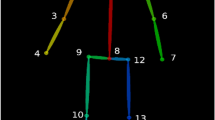Abstract
In this paper, we present a method to describe the continuum of human gait in an invariant manner. The gait description is based on the duty-factor which is adopted from the biomechanics literature. We generate a database of artificial silhouettes representing the three main types of gait, i.e. walking, jogging, and running. By generating silhouettes from different camera angles we make the method invariant to camera viewpoint and to changing directions of movement. Silhouettes are extracted using the Codebook method and represented in a scale- and translation-invariant manner by using shape contexts and tangent orientations. Input silhouettes are matched to the database using the Hungarian method. We define a classifier based on the dissimilarity between the input silhouettes and the gait actions of the database. This classification achieves an overall recognition rate of 87.1% on a diverse test set, which is better than that achieved by other approaches applied to similar data. We extend this classification and results show that our representation of the gait continuum preserves the main features of the duty-factor.
Similar content being viewed by others
References
Alexander R.: Optimization and gaits in the locomotion of vertebrates. Physiol. Rev. 69(4), 1199–1227 (1989)
Alexander R.: Energetics and optimization of human walking and running: the 2000 Raymond Pearl Memorial Lecture. Am. J. Hum. Biol. 14(5), 641–648 (2002)
Belongie S., Malik J., Puzicha J.: Shape matching and object recognition using shape contexts. PAMI 24(4), 509–522 (2002)
Blank, M., Gorelick, L., Shechtman, E., Irani, M., Basri, R.: Actions as space-time shapes. In: ICCV (2005)
Collins, R., Gross, R., Shi, J.: Silhouette-based human identification from body shape and gait. In: FGR (2002)
Cutler R., Davis L.S.: Robust real-time periodic motion detection, analysis, and applications. PAMI 22(8), 781–796 (2000)
Dollár, P., Rabaud, V., Cottrell, G., Belongie, S.: Behavior Recognition via Sparse Spatio-Temporal Features. In: VS-PETS (2005)
Fihl, P., Corlin, R., Park, S., Moeslund, T., Trivedi, M.: Tracking of individuals in very long video sequences. In: Int. Symposium on Visual Computing. Lake Tahoe, Nevada, USA (2006)
Jiang, H., Drew, M.S., Li, Z.N.: Successive convex matching for action detection. In: CVPR (2006)
Kim K., Chalidabhongse T., Harwood D., Davis L.: Real-time foreground–background segmentation using codebook model. Real-time Imaging 11(3), 172–185 (2005)
Laptev, I., Marszalek, M., Schmid, C., Rozenfeld, B.: Learning realistic human actions from movies. In: CVPR. Alaska, USA (2008)
Liu, Z., Malave, L., Osuntugun, A., Sudhakar, P., Sarkar, S.: Towards Understanding the limits of gait recognition. In: Int. Symposium on Defense and Security. Orlando, Florida, USA (2004)
Liu Z., Sarkar S.: Improved gait recognition by gait dynamics normalization. PAMI 28(6), 863–876 (2006)
Masoud O., Papanikolopoulos N.: A method for human action recognition. Image Vis. Comput. 21(8), 729–743 (2003)
Niebles, J.C., Wang, H., Fei-Fei, L.: Unsupervised learning of human action categories using spatial-temporal words. In: BMVC (2006)
Papadimitriou C., Steiglitz K.: Combinatorial Optimization: Algorithms and Complexity. Courier Dover Publications, Mineola, NY, USA (1998)
Patron, A., Reid, I.: A probabilistic framework for recognizing similar actions using spatio-temporal features. In: BMVC (2007)
Ran Y., Weiss I., Zheng Q., Davis L.S.: Pedestrian detection via periodic motion analysis. IJCV 71(2), 143–160 (2007)
Robertson, N., Reid, I.: Behaviour understanding in video: a combined method. In: ICCV (2005)
Schüldt, C., Laptev, I., Caputo, B.: Recognizing human actions: a local SVM approach. In: ICPR (2004)
Tenenbaum J., Silva V., Langford J.: A global geometric framework for nonlinear dimensionality reduction. Science 290(5500), 2319–2323 (2000)
CMU Graphics Lab Motion Capture Database (2007). http://mocap.cs.cmu.edu/
Poser (ver. 6.0.3.140) (2007). http://www.e-frontier.com/go/poser/
Troje N.F.: Decomposing biological motion: a framework for analysis and synthesis of human gait patterns. J. Vis. 2(5), 371–387 (2002)
Veeraraghavan A., Roy-Chowdhury A., Chellappa R.: Matching shape sequences in video with applications in human movement analysis. PAMI 27(12), 1896–1909 (2005)
Viola P., Jones M.J., Snow D.: Detecting pedestrians using patterns of motion and appearance. IJCV 63(2), 153–161 (2005)
Wang L., Tan T.N., Ning H.Z., Hu W.M.: Fusion of static and dynamic body biometrics for gait recognition. IEEE Trans. Circuits Syst. Video Technol. 14(2), 149–158 (2004)
Whittle M.W.: Gait Analysis: An Introduction. Butterworth-Heinemann Ltd., London (2001)
Wong, S.F., Cipolla, R.: Extracting spatiotemporal interest points using global information. In: ICCV. Rio de Janeiro, Brazil (2007)
Yam, C., Nixon, M., Carter, J.: On the relationship of human walking and running: automatic person identification by gait. In: ICPR (2002)
Yang, H.D., Park, A.Y., Lee, S.W.: Human–robot interaction by whole body gesture spotting and recognition. In: ICPR (2006)
Author information
Authors and Affiliations
Corresponding author
Additional information
This work is supported by the EU project HERMES (FP6 IST-027110).
Rights and permissions
About this article
Cite this article
Fihl, P., Moeslund, T.B. Invariant gait continuum based on the duty-factor. SIViP 3, 391–402 (2009). https://doi.org/10.1007/s11760-008-0089-9
Received:
Revised:
Accepted:
Published:
Issue Date:
DOI: https://doi.org/10.1007/s11760-008-0089-9




